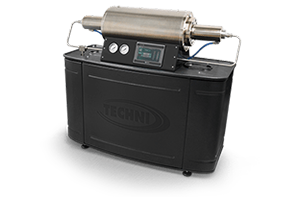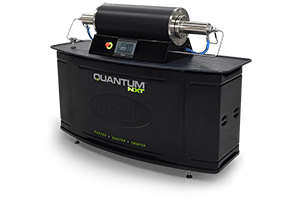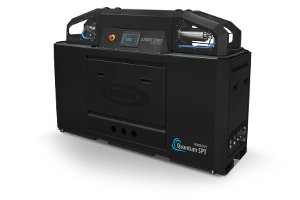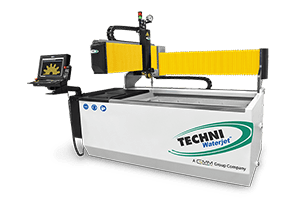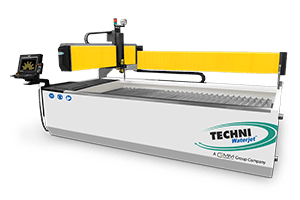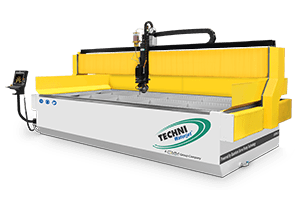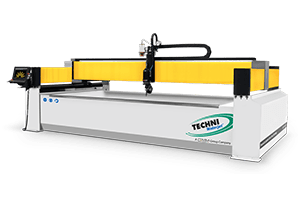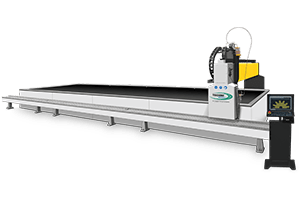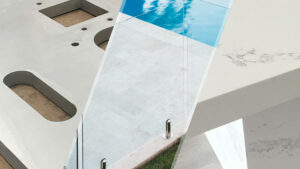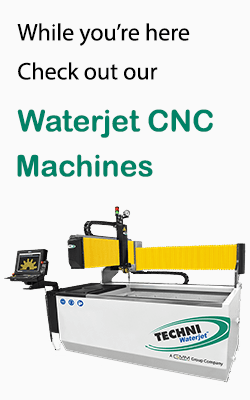The aerospace industry is based on innovation and pushing the boundaries of what is possible. For this reason, the machining methods employed in this industry are based on what can work on new materials with extreme hardness and, at the same time, provide extreme precision.
Waterjet cutting has been one of the favorite manufacturing processes in the aerospace industry due to the countless benefits it provides. This article will explore the application of water jet cutting technology in the aerospace industry along with the different materials it works with, its benefits, and the parts it creates.
Waterjet Cutting Overview
Waterjet cutting technology utilizes the significant force of high-pressure water to cut material. The water stream in this method can have a width less than a human hair to increase its impact. A waterjet cutter can cut through virtually any material, be it metals, non-metals, wood, plastics, ceramics, glass, and more.
When cutting harder materials, abrasives are added to the water to speed up the cutting process. This process then becomes abrasive waterjet cutting. Aerospace manufacturing usually utilizes abrasive waterjet cutting.
How Does the Aerospace Industry Use Waterjet Cutting Technology?
The aerospace industry uses waterjet machining as the go-to cutting technology. This is true for not only small intricate parts but also for large aerospace components. Waterjet cutters can not only cut sheet metal but even metal blocks that are around 18 inches thick. This turns out to be a major benefit for the aerospace industry since they deal with large-scale parts.
For soft components like foam insulation or any rubber seals, pure waterjet cutting is utilized. For harder components such as engine blocks, aerospace manufacturing relies on abrasive waterjet cutting.
What Aerospace Materials Can Be Cut By a Waterjet?
A waterjet cutter can cut a wide range of materials used in the aerospace industry. These materials include:
Aluminum
The high strength-to-weight ratio and other physical characteristics of aluminum make it extensively usable in the aerospace industry. With waterjet cutting, professionals can cut all the different types of aluminum such as Alumold, 6061 Aluminum, Cast Aluminum, Fatigue Resistant 2021 Aluminum, and many other types of aluminum alloys.
Titanium
Titanium ranks relatively high on the hardness scale. Therefore, most cutting methods find it hard to cut titanium in the required time or precision. However, waterjet cutting stands up to the challenge quite well. Therefore, titanium components in aerospace equipment are machined with a waterjet cutter.
Steel
Steel is one of the most commonly used industrial materials. It comes in a variety of forms such as stainless steel, carbon steel, mild steel, and more. Waterjet technology is used for steel cutting in a wide range of industries where steel is used, including aerospace.
Glass
In the aerospace sector, glass is used for making aircraft canopies, for control surfaces, for prototypes, and for many other specialist equipments. Waterjet cutting of glass provides a good way to handle the delicate nature of glass without damaging it. This method can be used for both- cutting and etching on glass surfaces.
Plastic
Plastics are utilized in a number of forms in the aerospace industry. The lightweight nature and high strength of plastics (like carbon fiber reinforced polymer) make them usable for a variety of tasks, from making valve seals to making the entire interior of aircraft. Water jet cutting is a great way to cut all types of different plastics with extreme precision.
Rubber
Rubber components are used in aircraft systems for seals, pressure maintaining systems, to hold different parts in place, and for many other utilities. Waterjet cutting can work on rubber even without the addition of abrasives to it.
Foam
In the aerospace sector, foam is commonly used for insulation, seat cushioning of commercial aircraft, separators, class segments, and baggage sections. Foam cutting can be achieved with a pure waterjet just like rubber, saving costs and increasing precision.
Fabric
Fabrics are employed in the aerospace industry for making gravity suits, parachutes, cargo liners, thermal blankets, interiors, and more. The textiles used in the aerospace industry require high cutting accuracy, especially for applications such as parachutes where the operator’s life depends on it. Additionally, there can be no heat-affected zones since they cause weakness. Therefore, waterjet cutting turns out to be a great way to achieve these requirements.
Where is water jet technology applicable in the aerospace industry?
Waterjet cutting is used for making a lot of different parts and components in the aerospace industry. These parts include:
- Engine components
- Aircraft body panels
- Turbine blades
- Modern aircraft engines
- Wide-chord aircraft engine
- Valve components
- Aircraft engine airfoils
- Shafts
- Aircraft engine fan blades
- Aircraft engine shaft
- Aircraft engine coating systems
- Castings
- Seats
- Aircraft groundings
- Aircraft components for oxygen generation systems
- Structural components
- Wing sections such as aircraft wing ribs
- Aircraft fuselages
- Brake components
- Aircraft landing gear components
- Titanium bodies for military aircraft
- Interior cabin panels
- Carpeting
- Insulation
What makes waterjet machines the best option for the aerospace industry?
There are a number of factors that make water jet technology the ideal cutting process in the aerospace sector. These factors are:
- Versatility: Waterjet cutting can be used for virtually any material in the aerospace sector. This includes hard materials like metal, alloys, and ceramics as well as soft materials like foam and rubber.
- Precision: Water jet cutting is one of the most accurate cutting processes out there. The cutting tolerances are extremely low, regardless of the material that it is cutting. This turns out to be a defining factor for the aerospace industry.
- High-Quality Finish: The parts processed with a water jet cutter have an extremely smooth cut quality. This eliminates the need for any secondary finishing, speeding up the time frame for the project.
- Complex Parts: Multi-axis waterjets, such as the 5-axis waterjet cutters, can create the complex geometry of intricate parts. They can even work inside the cavities where other cutting methods fail to operate. This is another big bonus for the aerospace industry, known for high complexity of components.
- Scalable Solution: Waterjet cutters can make parts of any size, from small screws or large landing gear struts. In fact, the same machine can create all the different sized components.
- No Heat-Affected Zones: Most cutting processes generate temperature rise, which forms heat-affected zones near the cut edges. These zones alter the characteristics of the material, such as weakening its physical strength. However, waterjet cutting is a cold-cutting process. Therefore, there are no heat-affected zones formed in this method. For instance, cutting 6061 aluminum with a laser cutter can damage the base material irrevocably.
- Non-abrasive Edges: Conventional cutting methods often create hard abrasive edges on the cut surface. These edges can cause injury to the operators or damage to the adjacent parts. However, waterjet cutting creates smooth edges without any hard and abrasive surfaces.
- No Wastage of Material: All the material removed by a waterjet cutter gets dissolved in the water and can be strained later. This is not true for other cutting methods where the removed raw materials become dust or slag, making them usable. Therefore, for expensive materials used in the aircraft industry, waterjet cutters bring another new cost-effective benefit.
- High Safety: Being a cold-cutting process, the waterjet does not create any toxic fumes or dust. This is quite beneficial when cutting materials like rubber or plastics, where the toxic fumes can be harmful to the health of the workforce.
- Environmentally Friendly: Waterjet cutting is a green technology. The water used in the method is generally recycled back into the system. The material removed can be recycled as well. This reduces the environmental impact of the entire machining process in the aircraft industry.
- Long-Lasting Parts: In cutting processes that create heat-affected zones, there is the propagation of microscopic indications with time. This happens due to the cyclical and static loads that are faced by the part and is termed metal fatigue. In the case of waterjet cutting, no such fatigue is formed, resulting in a long-lasting component.
Where to Find CNC Waterjet Cutting Machines?
Techni Waterjet is the primary supplier of high-quality water jet cutters for the aerospace industry. These cutters are designed with extensive experience and keeping in mind the specialized requirements of the industry, such as high precision and rugged design.
Conclusion
There is no doubt that water jet cutting is a great way to meet the challenges of the modern aircraft and aerospace industry. This technology can handle all the cutting requirements of aircraft structural and functional components. Even aerospace industry leaders such as Lockheed Martin use waterjet technology when crafting their parts.
Therefore, if you are wondering whether waterjet technology can meet your requirements, it most definitely can. Get in touch with Techni Waterjet to discuss more.
